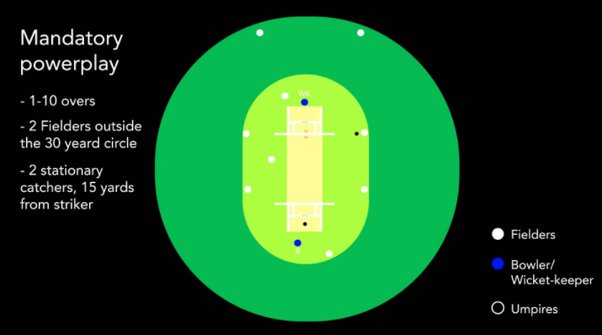Powerplay is a set of over’s that applies fielding restrictions. It is a key aspect of the game and planning an innings around it can make or break the game for teams.
The first batting powerplay is mandatory and allows two fielders outside the 30-yard circle. After that, the batting side can choose two more 5-over powerplay phases at their choice.
First Powerplay
When fans turn up to watch limited overs cricket they want to see lots of boundaries being hit and runs being scored. However, if fielding captains and bowlers began to play defensively and set defensive fields it would slow down the rate at which runs are scored. To avoid this, the ODI game has three ’powerplay’ periods that apply different fielding restrictions.
During the first powerplay period (overs 1-10) only two fielders can stand outside of the 30-yard circle. This allows the batters to play in a more attacking manner and try to score a large number of runs. If a batter is facing five fielders on the boundary it will be very difficult for them to pick up large numbers of boundaries. In order to do so they will have to either be very creative and hit the ball in areas that the fielding team is not anticipating or have a lot of power to hit the ball over the heads of the fielders.
This is why teams invest so much in strong opening batsmen that can exploit the fielding restrictions during this period of the match. The best batters can hit the ball for huge totals even when faced with tough fielding restrictions. The likes of New Zealand batter Martin Guptill have demonstrated this, scoring 93 runs in just 10 overs in one game.
Second Powerplay
During the second powerplay (overs 11-40) fielding restrictions are lifted and four fielders can be stationed outside the inner circle. This gives batting teams more protection and allows them to score more easily. During this phase of the game, the best batting sides will look to accelerate their run rate by hitting boundary after boundary. This is a crucial time to make sure that the innings gets off to a fast start, and many teams need good opening batsmen who can play aggressively and take advantage of the extra space.
Moreover, the second powerplay also gives bowlers more fielding protection because they can place more fielders on the leg side and behind square. This helps to prevent batters from pre-meditating a certain type of ball and hitting it powerfully. The best bowlers will also use their variations during this period and mix up their lengths so that the batters can’t predict what they’re going to get.
While the powerplay rules have made ODI cricket more exciting, they’ve also created some issues. For example, batting teams have tended to over-utilize the powerplay and risk losing wickets in the middle overs. This has caused the middle overs to become a lull point in the innings, which has not been ideal for the overall match outcome. Hopefully, the ICC will continue to adapt and develop the powerplay rules in order to minimize these issues in future.
Third Powerplay
The batting side gets to choose two five-over powerplays from overs 11 to 50 in an ODI match. The bowling side can have fielders outside the 30-yard circle for the first 10 overs of these phases. Then they can have three fielders on the leg side and behind square for the remaining overs of powerplays. Many of the biggest cricket leagues around the world follow this rule.
The powerplay rule is a modern addition to limited-overs cricket, but the fielding restrictions for the bowling team have been in place since the 1970s. These restrictions were changed a few times, but the current version was established in 2005.
During the powerplay phase, batters can score a lot of runs quickly. The goal of the bowling team is to take as many wickets as possible in this phase and slow down the batting side. This can help to make the game more exciting and even lead to a high score in the end.
If the bowling team doesn’t take the wickets they need during the first powerplay, they might have a tough time defending their total in the rest of the innings. The bowlers should try to keep the ball unpredictable and vary their lengths and pace. This way, the batsman will be unable to pre-meditate and expect what is coming next.
Final Words
The powerplay in ODI cricket is one of the most important aspects of a match. Properly planning an innings around these overs can make the difference between victory and defeat for a team. The rules of batting powerplay have changed several times throughout history, but the current ruling is now in place and has been used since 2015.
The first phase, known as Mandatory Powerplay, comes in the first 10 overs of an ODI match and allows only two fielders outside the circle. The second phase is in the 11th to 40th overs and allows four fielders outside the circle. This gives bowlers a bit of relief in the game, which can make the game more interesting for spectators.
While batting powerplays have been in effect for a long time, there are still some misconceptions about how they work. For example, many people believe that the fielding captain can only put two fielders on the leg side of the ground. While this is true, the other fielders can be anywhere on the ground, including behind square.
Another important factor is the fact that the batsman can’t score more than four runs during the powerplays. This rule is designed to prevent teams from relying on powerplays to get them ahead in the game. It also helps to prevent bowlers from constantly bowling a barrage of short balls to batters who will top edge them or miscue their shots.






More Stories
The Importance of Sportsmanship